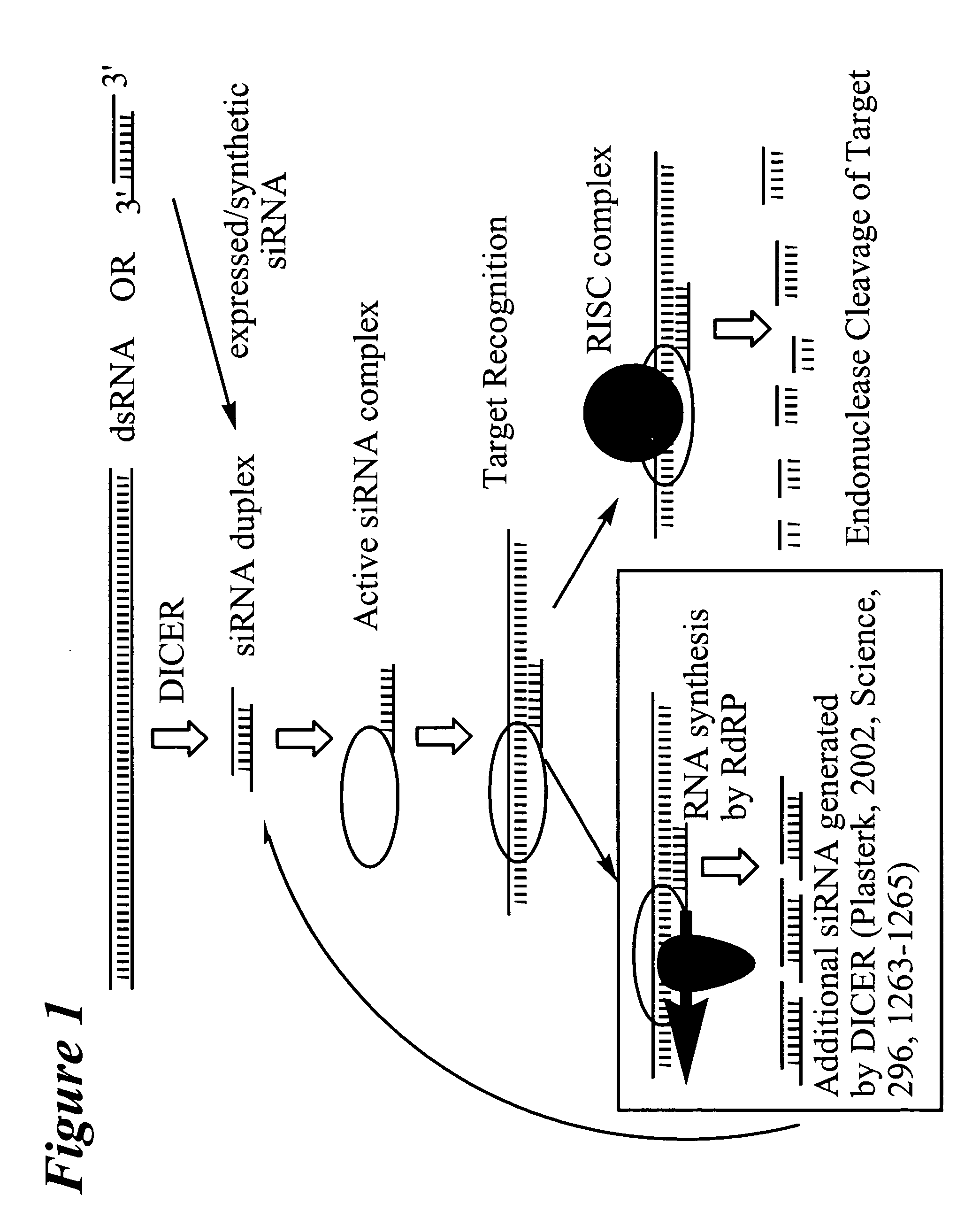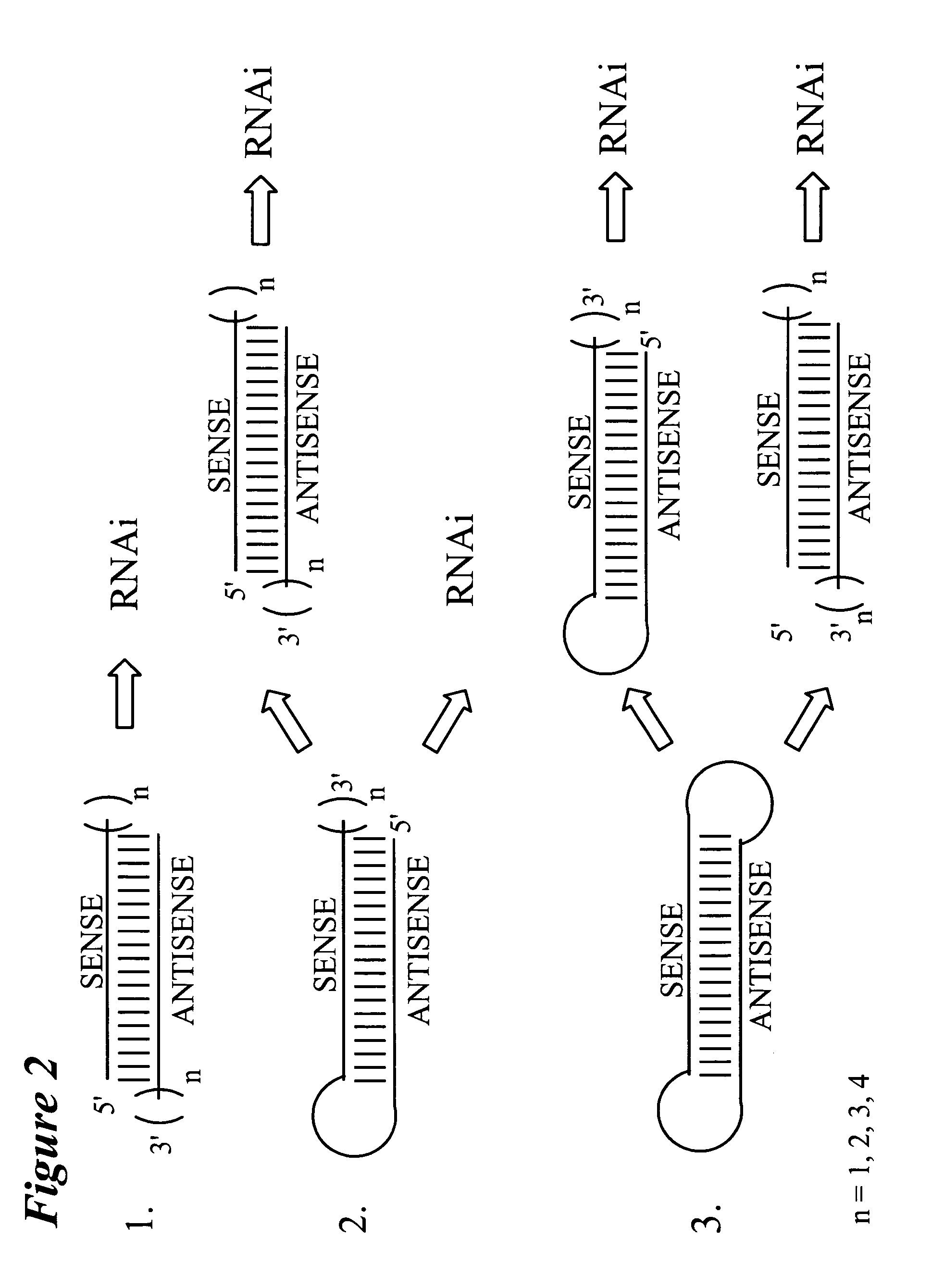RNA interference mediated target discovery and target validation using short interfering nucleic acid (siNA)
a technology of interfering nucleic acids and target discovery, which is applied in the field of target discovery and target validation, can solve the problems that the modification of kreutzer et al. cannot be demonstrated in the same way, and the interference activity cannot be assayed
- Summary
- Abstract
- Description
- Claims
- Application Information
AI Technical Summary
Benefits of technology
Problems solved by technology
Method used
Image
Examples
example 1
Target Discovery in Mammalian Cells
[0112] In a non-limiting example, compositions and methods of the invention are used to discover genes involved in a process of interest within mammalian cells, such as cell growth, proliferation, apoptosis, morphology, angiogenesis, differentiation, migration, viral multiplication, drug resistance, signal transduction, cell cycle regulation, or temperature sensitivity or other process. First, a randomized siNA library is generated using a process outlined in FIG. 8 for hairpin siNA constructs or in FIG. 9 for double stranded siNA constructs. These constructs are inserted into a vector capable of expressing a siNA from the library inside mammalian cells.
Reporter System
[0113] In order to discover genes playing a role in the expression of certain proteins, such as proteins involved in a cellular process described herein, a readily assayable reporter system is constructed in which a reporter molecule is co-expressed when a particular protein of in...
example 2
Target Discovery for Genes Associated with Mucin Production
[0121] A target discovery and target validation approach is used to find genes that are involved in chronic mucous hypersecretion involved in chronic obstructive pulmonary disease (COPD).
Reporter System
[0122] In order to discover genes playing a role in the expression of mucins, a readily assayable reporter system is devised. The reporter system consists of a plasmid construct, termed pMUC5AC-EGFP, bearing a gene coding for Green Fluorescent Protein (GFP). The promoter region of the GFP gene is replaced by a portion of the Mucin 5AC promoter sufficient to direct efficient transcription of the GFP gene. The plasmid also contains the neomycin drug resistance gene.
Host Cell Line for Target Discovery
[0123] The cell line selected as host for these studies, NCI-H292 (ATCC CRL-1848), is derived from a human lung mucoepidermoid carcinoma. The cells retain mucoepidermoid characteristics in culture and endogenously express muci...
example 3
Discovery of Genes Involved in Plant Male Sterility
[0130] When two genetically distinct plant lines are crossed with each other, a variety of beneficial attributes may be combined into one single hybrid. The use of this technique for the development of hybrid seeds allows for increased agronomic benefits. Desirable attributes for plants include fruit size, growth rate, germination, yield sizes, and disease, temperature, and insect resistance. Generally speaking, this process involves generation of inbred crop lines, breeding between these lines, followed by determination whether the hybrids are superior to the original lines. For this process to be successful however, a means of preventing self-pollination must be implemented to improve cross-pollination rates. Seed generated through self-pollination would contaminate the supply of hybrid seed. By causing male or female sterility in crops, the plants would have to rely on cross breeding to reproduce. Within the context of this appl...
PUM
| Property | Measurement | Unit |
|---|---|---|
| pH | aaaaa | aaaaa |
| pH | aaaaa | aaaaa |
| temperature sensitivity | aaaaa | aaaaa |
Abstract
Description
Claims
Application Information
 Login to View More
Login to View More - R&D
- Intellectual Property
- Life Sciences
- Materials
- Tech Scout
- Unparalleled Data Quality
- Higher Quality Content
- 60% Fewer Hallucinations
Browse by: Latest US Patents, China's latest patents, Technical Efficacy Thesaurus, Application Domain, Technology Topic, Popular Technical Reports.
© 2025 PatSnap. All rights reserved.Legal|Privacy policy|Modern Slavery Act Transparency Statement|Sitemap|About US| Contact US: help@patsnap.com



